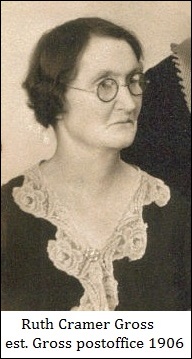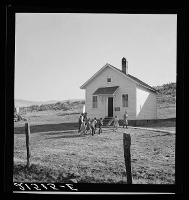Gross Post Office
Gross post office was established April 11, 1906, by Ruth E. (Cramer) Gross. Subsequent postmistresses were Mrs. Jo K. Nesbitt, appointed November 1919; and Mrs. Anna Query, appointed October 1919. - Post Office History

Hester Gross MacAskill writes in Childhood on Upper Squaw Creek, 1978:
"As far as I was concerned there was always a Gross post office and a Gross school but I know that was not so. Which came first, I do not know, but I presume it was the post office."When a post office was to be formed a name was asked for, my mother and Aunt Ruth decided the name of Gross should be submitted. The name of Boston* was also sent in. They were early day settlers on Squaw Creek, the place Nesbitt's now have. My Aunt Ruth was the post mistress and the post office was held in her home. She had that for a number of years. When she gave it up, Io Nesbitt had it in her home, on the place where Homer Nesbitt now lives. Mrs. Nesbitt had the post office for quite a few years. It was still called the Gross post office. When she gave it up, it reverted back to a route as it is now."
* Will Boston was the original homesteader of portions of Sections 2 and 11, Twp. 11 North, Range 1 East, B.M., later owned by Nesbitts. He was Liza Jane Coggburn's brother; therefore, the brother-in-law of Hester's great uncle Jack Coggburn. His wife Mattie died June 1900 and is buried in the Ola Cemetery. All three families -- the Cramers, the Coggburns and the Bostons -- were from Taney County, in southwest Missouri.
Richard & Ruth Gross family sheet.
Gross School

(Gross) School attended by children of members of 1939 Ola self-help sawmill co-op (click for larger image)
extracted from "The Gross Family Geneology and Story," compiled by June Granger Beeson, 1985., p. 5f.
"At the time (mother) Josie (b. 1895) was ready for school, parents were required to send their children to school for only twelve weeks a year, at least eight of which were to be consecutive. At the time the Gross children went to school the school term was sometimes only for the four months, sometimes five months, or six months at the most. When Josie was in the first grade, the school was located at Glen Cove*. There were twelve pupils enrolled in the school. When she was in the third grade and Janie was in the first grade, the school was at Boston. By the time Willie had joined his sisters in school, the school was at Gross and the rest of the children all attended the Gross school. The grand-children even attended this school. The schools were all in the same area over a little hill or down a draw from the other one. Some of the families lived too far away from a school for the children to attend in the winter. The mother would have to leave their home and stay with the children close to the school in order that the children could attend school.
"The winter term of 1908-1909 found (father) Harry L Granger teaching his first school. Annie and Ruth Gross and Mrs. Ella Tiller were on the school board. The young teacher boarded at the Richard and Ruth Gross home. There were twenty-eight pupils that year — quite a handful for a young eighteen year old teacher, teaching his first school, all grades and all in one room! Josie, the oldest of the Gross children was thirteen by this time. Harry only taught the one term at Gross but a friendship started between pupil and teacher that later developed into love and marriage.
"Many years later after the Gross children were out of school, there developed a dispute over where the school should be located. One faction wanted it kept where it was and another faction wanted it over on the Pine Creek side. No agreement was reached. One night the Gross school house burned down. Then the new school was put over by Pine Creek. One winter of heavy snow the school house caved in. That was the end of the Gross school and the children were then taken to Ola for their schooling. Ola still has the school for the first eight grades.
"The Gross school was about two and one-half miles from the ranch house. There was a trail through the hills that the neigh-borhood children and the Gross children used in the fall when the weather was nice. The trail up over the last steep hill before you get to the flat where the Gross school was located is still visible today. In bad weather the children rode horses and they had to keep to the road. Gustav made a cutter (sleigh) to use when the snow was too deep and the weather too cold for' the children to ride their horses. Gustav put hay in the sleigh and there were plenty of their home-made quilts to keep the kiddies warm. Annie heated rocks to keep the children's toes toastie warm. In the winter when the snow was right for sledding, the children took a big board up the hill from the school house at recess time and they would slide down, riding it all the way down to the bottom of the hill. Then back up the hill they would trudge and down they would go again. It was fun!
"Although the term was short the teacher crammed a lot of subjects into their day. These were the subjects they were graded on: Reading, Spelling, Writing, Arithmetic, Geography, Grammar or Language, Memory Work, Physiology and Hygiene, Deportment, U. S. History, Civil Gov't, Composition. One term, in addition to the above, there was added "Mental Arithmetic." After you completed your eighth year of study, a State exam was given to see if you had learned enough to have completed your course of study. If one didn't pass the State examination you had to study some more and take the State exam again the next year.
"The State examination had to be completed in order for you to go on to high school. The young people had to go out to Boise to high school. Boise opened Idaho's first public high school in 1882. It was the only public high school during the territorial period. Later on there was a high school at Emmett for Upper Squaw Creek Valley's young people to attend. After Hester passed her eighth grade State exam she went to Boise High School, working for her room and board while attending school. The State examination was given by the County Superintendent of Schools, headquartered at Idaho City, the county seat of Boise County. The Squaw Creek area was in Boise County until 1915 when the State legislature created Gem County.
"The Gross children were proud when they received their diploma.
DIPLOMA FROM "IDAHO PUBLIC SCHOOLS"
This certifies that __________ has honorably completed the Course of Study in the various Branches prescribed to be taught in the Public Schools of Boise County. Orthography, Reading, Writing, Arithmetic, English, Grammar, Geography, United States History, Physiology, Civil Government, and is entitled to receive this Diploma. Signed by the teacher Signed by the County Superintendent of Schools.". . . In warm weather, the children walked to school, carrying their shoes. They didn't put them on until they got to the school. Of course they all liked to go barefoot as much as possible anyway but they did this to make their shoes last longer, not only because they were thrifty, but also because their shoes had to last. They only made two trips a year to Boise for their supplies – once in the spring and again in the fall. Mr. Glenn built a small store at Ola around 1908 but it was to Boise that the Grosses went to get their supplies. Everything had to last until the next trip. The trip had to be carefully planned that nothing be forgotten, the staples, the calico for Annie to sew into dresses. The year Josie was born (1895) seventy-three cents would buy ten yards of calico. Annie purchased yards of outing flannel, not only for their night clothes but also most of the girl's dresses were made out of outing flannel, much to the chagrin of the girls as they got older and visited outside of Ola and found that the other young ladies did not wear outing flannel dresses."
Notes: A search for "Glen Cove" school on USGS index of Geographic Names revealed nothing. According to Hester's account, "Annie and Gustav began their married life on Hog Creek near Midvale where my father was on a ranch in partners with his brother Frank, a bachelor." (see Childhood on Upper Squaw Creek). It is possible that Josie did not start school from the 3rd Fork homestead. A search of the 1893 glo plat shows both J. E. Glenn and T. Boston in Section 36, near where William Cramer (great-great-grandfather) later homesteaded. Gross Homesteads, GLO listing Cramer Homesteads, GLO Listing
In May 1963 the school district quitclaimed the one acre site to Franklin Elliott, Gem County Records, Instrument No. 93316.
School Districtsmap
Family Group Sheets
William H. Cramer
Gustav A. Gross
Richard Gross

Webspace for this site is generously provided by Genealogy Village and Access Genealogy
Copyright © 2013 - Sharon McConnel. All Rights Reserved.
